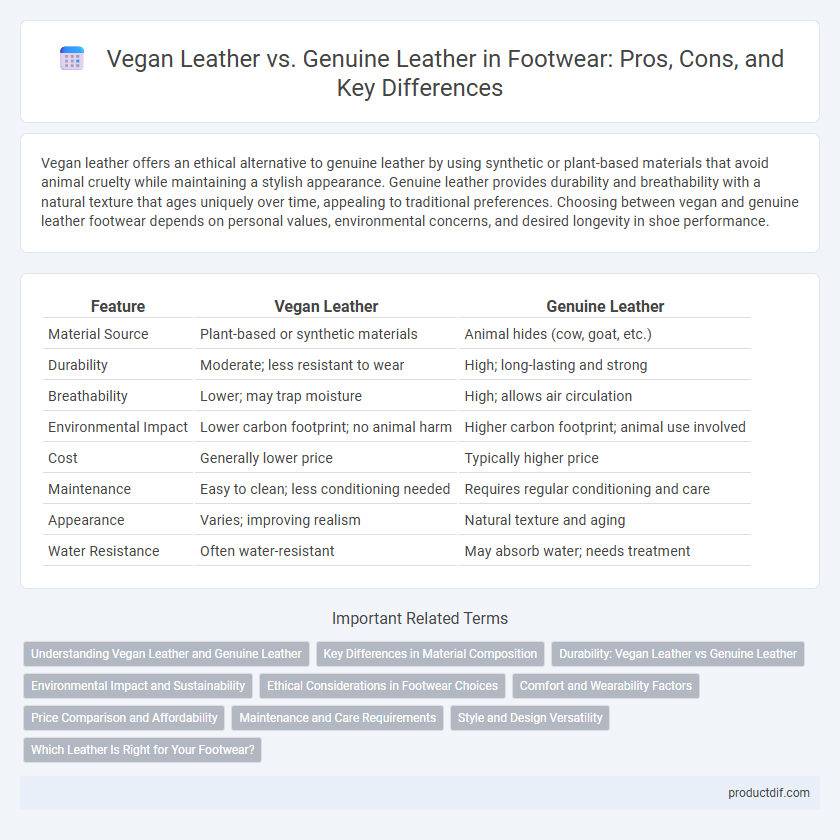Vegan leather offers an ethical alternative to genuine leather by using synthetic or plant-based materials that avoid animal cruelty while maintaining a stylish appearance. Genuine leather provides durability and breathability with a natural texture that ages uniquely over time, appealing to traditional preferences. Choosing between vegan and genuine leather footwear depends on personal values, environmental concerns, and desired longevity in shoe performance.
Table of Comparison
| Feature | Vegan Leather | Genuine Leather |
|---|---|---|
| Material Source | Plant-based or synthetic materials | Animal hides (cow, goat, etc.) |
| Durability | Moderate; less resistant to wear | High; long-lasting and strong |
| Breathability | Lower; may trap moisture | High; allows air circulation |
| Environmental Impact | Lower carbon footprint; no animal harm | Higher carbon footprint; animal use involved |
| Cost | Generally lower price | Typically higher price |
| Maintenance | Easy to clean; less conditioning needed | Requires regular conditioning and care |
| Appearance | Varies; improving realism | Natural texture and aging |
| Water Resistance | Often water-resistant | May absorb water; needs treatment |
Understanding Vegan Leather and Genuine Leather
Vegan leather is a synthetic material made from polyurethane or plant-based sources, designed to mimic the look and feel of genuine leather while being cruelty-free and environmentally friendly. Genuine leather is derived from animal hides, known for its durability, breathability, and natural aging properties that improve with use. Understanding the key differences in composition and sustainability helps consumers make informed choices between ethical concerns and traditional quality.
Key Differences in Material Composition
Vegan leather is made from synthetic materials such as polyurethane or plant-based sources like cork and apple peels, offering a cruelty-free alternative to genuine leather, which is derived from animal hides primarily composed of collagen fibers. The manufacturing process for vegan leather involves polymer coating and embossing to mimic the texture of real leather, whereas genuine leather undergoes tanning and finishing treatments to enhance durability and appearance. These fundamental differences in material composition impact breathability, biodegradability, and environmental footprint, with genuine leather being more breathable but less eco-friendly compared to most synthetic vegan leathers.
Durability: Vegan Leather vs Genuine Leather
Genuine leather typically offers superior durability compared to vegan leather, withstanding wear and tear over extended periods due to its natural fiber structure. Vegan leather, often made from polyurethane or plant-based materials, tends to show signs of cracking and peeling faster, especially when exposed to heat and moisture. Advances in manufacturing have improved the lifespan of some high-quality vegan leathers, but genuine leather remains the preferred choice for long-lasting footwear durability.
Environmental Impact and Sustainability
Vegan leather, often made from polyurethane or plant-based materials like pineapple leaves and cactus, offers a more sustainable alternative by reducing reliance on animal agriculture, which is a major contributor to deforestation and greenhouse gas emissions. Genuine leather production involves intensive water use, chemical treatments, and methane emissions from livestock, posing significant environmental challenges. Choosing vegan leather can lower carbon footprints and prevent pollution, though the biodegradability and eco-friendliness vary depending on the specific materials and manufacturing processes used.
Ethical Considerations in Footwear Choices
Choosing vegan leather over genuine leather in footwear reflects a commitment to animal welfare by avoiding the use of animal hides and reducing the environmental impact associated with livestock farming. Vegan leather options, typically made from synthetic or plant-based materials, minimize ethical concerns related to animal cruelty and promote sustainable production practices. Consumers prioritizing ethical footwear often seek brands that ensure cruelty-free sourcing and lower carbon footprints, aligning fashion with conscientious values.
Comfort and Wearability Factors
Vegan leather footwear often provides lightweight and breathable qualities that enhance comfort, making it suitable for extended wear in warmer climates. Genuine leather, known for its natural flexibility and ability to mold to the foot over time, typically offers superior durability and support for long-term use. Both materials impact moisture management and temperature regulation differently, influencing overall wearability based on individual preferences and activity levels.
Price Comparison and Affordability
Vegan leather footwear typically costs 20-50% less than genuine leather due to lower material and production expenses. Mass production of synthetic alternatives further enhances affordability, making vegan options accessible to budget-conscious consumers. Genuine leather shoes, while more expensive, often justify their price with durability and natural breathability, appealing to buyers prioritizing long-term value.
Maintenance and Care Requirements
Vegan leather requires less intensive maintenance compared to genuine leather as it is water-resistant and can be cleaned easily with a damp cloth, avoiding the need for conditioning or polishing. Genuine leather demands regular conditioning with leather-specific products to prevent drying, cracking, and to maintain its natural suppleness and breathability. Proper care of genuine leather includes avoiding excessive moisture and direct sunlight, while vegan leather is more durable in varying weather conditions but may be prone to surface cracking over time without gentle cleaning.
Style and Design Versatility
Vegan leather offers a wide range of colors and textures, enabling designers to experiment with bold, contemporary styles that genuine leather may not easily achieve. Genuine leather provides a natural, rich patina that enhances classic and timeless designs, appealing to traditional aesthetics. Both materials support diverse design versatility, but vegan leather's synthetic nature allows for innovative finishes and customization options that broaden style possibilities.
Which Leather Is Right for Your Footwear?
Choosing between vegan leather and genuine leather for footwear depends on durability, environmental impact, and personal ethics. Genuine leather offers superior breathability and long-lasting wear but involves animal products and higher environmental costs. Vegan leather provides a cruelty-free, water-resistant alternative often made from synthetic or plant-based materials, appealing to those prioritizing sustainability and animal welfare.
Vegan Leather vs Genuine Leather Infographic

 productdif.com
productdif.com